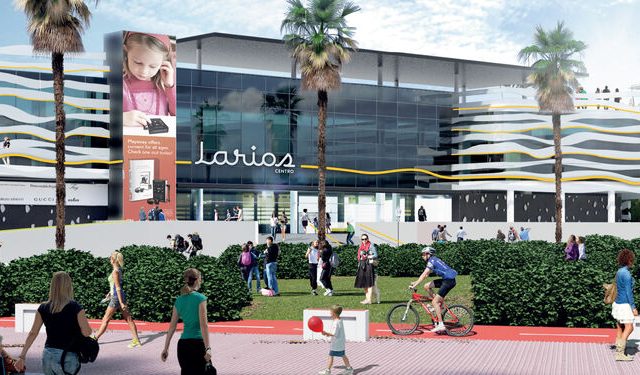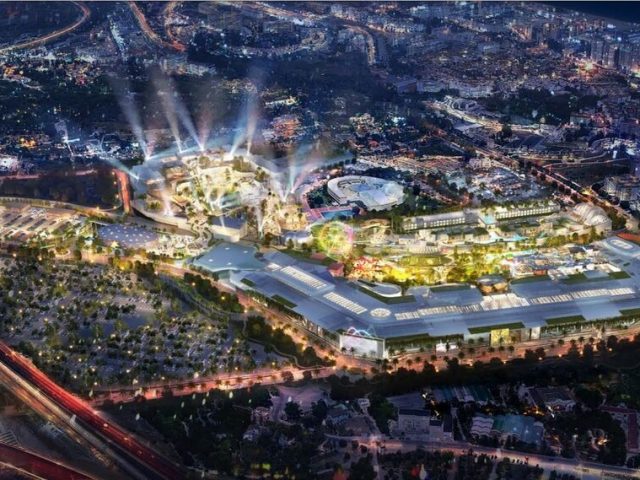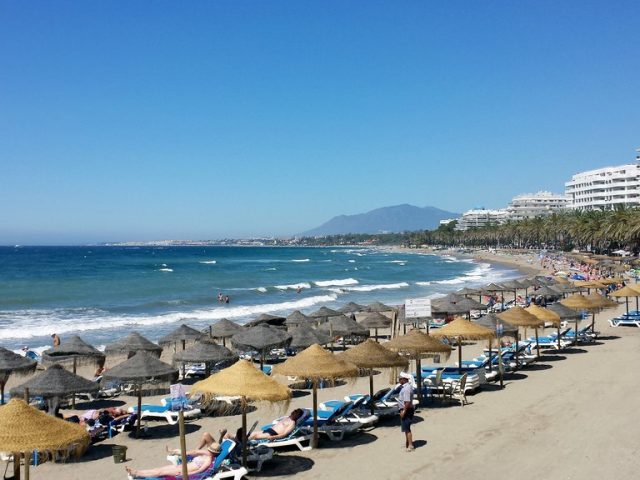- Have any questions?
- +34 951 273 575
- info@allaboutandalucia.com
The different worlds of the Guadalhorce Valley

Torremolinos: The LGBT capital of the Costa del Sol
May 7, 2015
Alhaurin’s castle in the sky
May 30, 2015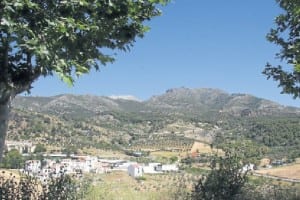
BREATH-TAKING: View across the valley near Alozaina
KNEES knocking, hands scrabbling for something to grip on the crumbling rock face, at last I found a foothold on the sheer-sided cliff and breathed a sigh of relief.
Precariously perched 10 metres above one of Ardales’ shimmering turquoise lakes, I snuck a quick look at the dizzying mountain backdrop before letting go, plunging from my rocky eyrie to pierce the smooth glass surface of the water below.
As I emerged from the crystal clear water (shaking my curly locks, Baywatch-style) I was greeted by congratulatory cheers from onlookers awaiting their turn above me.
It’s fair to say that my first experience of the Guadalhorce Valley took my breath away!
Reached from Marbella on the Coin road, via the white-washed pueblos of Ojen, Guaro and Monda with its impressive hilltop castle, it’s hard to believe that this stunning valley is just 45 minutes from the hustle and bustle of the Costa del Sol.
Once a best-kept secret, this summer thousands of new visitors will discover this little-known natural beauty spot on a mission to take the El Chorro Challenge.
The Caminito del Rey is already a big hit with thrill seekers. Dubbed the ‘world’s deadliest walkway’ until its re-opening this Spring after a €2.8 million restoration, this high-adrenalin hike runs above the El Chorro gorge, an immense fissure five kilometres long and 300 metres deep, running between two towering limestone cliffs.
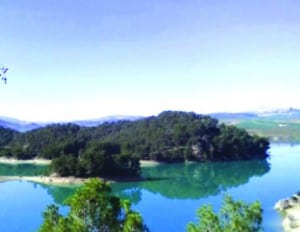
CRYSTAL CLEAR: Lake in Ardales, near El Chorro
El Chorro and Ardales, at the other end of the Caminito, are often called Andalucia’s Lake District and it’s easy to see why.
These two postage stamp-sized villages are linked by hairpin bend roads to three stunning, turquoise reservoirs bordered by sandy beaches and shaded by feathery conifers. The scenery is more akin to the countryside of Cumbria or the cantons of Switzerland than anything people imagine could be found on the Costa del Sol.
With lakeside camping sites, it’s the quintessential active weekend break for outdoor sports types, offering rock climbing, watersports, pedalos and dining under the stars at charming pine-shaded ventas.
The polar opposite to the glitz and glamour of the nearby coast, the valley offers a more peaceful, relaxed way of life… A more ‘typically Spanish’ lifestyle perhaps, something that’s also noticeable in the region’s bigger town’s – Coin, Alhaurin el Grande and Alhaurin de la Torre.
As English expat Ray Finch explains: “The Costa del Sol is great for people who love the beach and like to party, but up here in the hills, we get to experience the real Spain.”
Ray moved from London to Coin five years ago to retire and has never looked back.
“Why would I ever go back?” he protests. “I love it here, the scenery is incredible, the people are lovely and the way of life is so much easier-paced than it was back in London.”
Coin, the region’s ‘capital’ and largest town, is merely an up-scale version of its smaller neighbours (Tolox, Yunquera and Alozaina) with two main squares, an emblematic church at its centre and a multitude of winding cobbled streets, stacked either side with white-washed houses.
Named by the Romans, turned into a market town shortly after and then abandoned for almost 500 years, the Moors rebuilt most of Coin in 950 AD.
Marble and iron ore quarried from its hills into the 19th century were used in the construction of the Roman town of Italica, near Sevilla, birthplace of the future Emperor, Hadrian.
Reconquered by the Christians after a siege in which the legendary Christopher Columbus took part, it also had a special place in the heart of another great explorer, Captain Cook.

Historic castle in Alora
After a visit to Coin, Cartama and Alhaurin in 1829 he wrote: “These villages are on rising ground above the river and in beauty of situation and cultivation cannot be excelled.
“They afford a specimen of the whole country when possessed by the Moors, being surrounded by gardens with orange, lemon and palm trees and abounding in all the fine as well as the more common fruits.”
Even today, the Guadalhorce is considered to be among the most fertile valleys in all Spain.
Crisscrossed with streams, as well as modern and ancient acequias (man-made water channels), it is home both to wild nature and modern cultivation, while signs of its fecundity continue into the villages where you can pick oranges and lemons from ‘urban orchards’ of trees lining the streets!
To the west of the valley, verdant Sierra de las Nieves Natural Park has seen even less human interference.
Apart from the few towns and villages on its outskirts, the park is largely uninhabited, with a rich variety of pine, fir, ash, chestnut and oak trees, and countless streams and waterfalls.
A National Hunting Reserve teeming with mountain goats and mouflon deer, rambling, horse riding and river kayaking are all great ways to explore its undiscovered beauty.
The park is easily accessible from the picturesque villages of Tolox and Yunquera, which possess a charm all of their own.
Tolox is a tumble of white-washed houses where the villagers have even gone so far as painting the tree trunks white, to reinforce the pueblo blanco look.
Yunquera is slightly bigger, with one of the most picturesque church spires in the Guadalhorce Valley although its emblem is the ancient castle towering 500 metres above the village.
One of the highest points in Malaga province, El Castillo is believed to have been built by the Arabs and used as a watchtower during wars. Today this important heritage site has been refurbished to function as an information centre for the Sierra de las Nieves.
“Yunquera really is beautiful,” enthuses local artist Miguel Merchan.
“I often go down to the bottom of the town and look up at the white houses with the church spire sticking up in to the air. It makes me proud to be from such an inspiring place.”
After a lifetime dedicated to art, Merchan now runs a small museum in memory of his mentor, legendary local artist and musician Francisco Sola.
Set in Sola’s home, Merchan has recreated the artist’s study and turned the upper floors into a gallery showcasing some of his best works – many of them self-portraits and studies of his family.
Just 15 minutes from Yunquera, Alozaina is embedded like a jewel in a setting of olive groves.
The entrance to the village’s charming centre is marked by stone arches while the church – the crowning glory in most of these pueblos – can be seen against the skyline from the narrow streets below. From the striking Santa Ana church itself, there are spectacular views towards the Sierra Prieta.
I saved the best gem for last on my weekend in the Guadalhorce Valley – Alora, half an hour up the road.
Helping myself to the oranges and lemons dangling invitingly from the trees in the high street, I headed through bustling streets packed with Moroccan and Roman influences to the castle, which sits on a lofty pinnacle looking down on this quaint pueblo.
A stop at the 17th century La Encarnacion church en route is the perfect prelude to the main event atop Cerro de las Torres hill.
The castle has had a long and chequered history. Originally built by Phoenicians, before being expanded under Roman rule, it was destroyed by the Visigoths and rebuilt by the Moors.
Looking down one last time on this lush green valley, as the inhabitants of all these past civilisations must have done too, I felt a pang of regret to be leaving.
But then I remembered the best thing about the Guadalhorce. It’s so close to the coast it’s almost my back yard and I’ll be back there soon!


